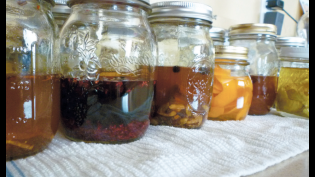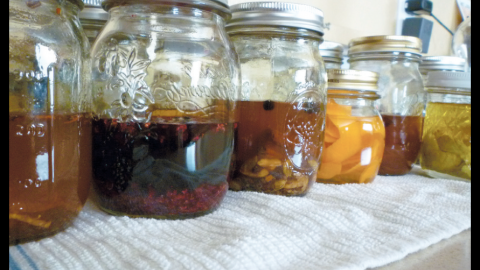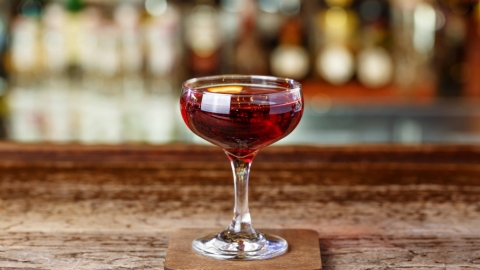AZ Bitters: The Bitters End
Cocktail trends come and go, and evidence suggests that one particular trend is nudging the tipping point: bitters.
The return to classic cocktails has fueled a renewed interest in bitters, a key ingredient in stalwart standards such as the Manhattan and the Sazerac. Former Gourmet editor Ruth Reichl put bitters on her 2012 trends list, and a new book, Bitters: A Spirited History of a Classic Cure-All with Cocktails, Recipes and Formulas by Brad Thomas Parsons was released late last year.
Bitters are highly concentrated flavoring agents, generally made by infusing botanicals with neutral grain spirits. The most widely known bitters are Angostura and Peychaud's, but the recent bitters explosion has brought multiple brands to the market, both mass-produced and artisanal smallbatch bitters.
For Valley residents Bill and Lillian Buitenhuys, bitters have become an obsession. The couple is documenting their exploration into the realm of bitters on Facebook through a community page called AZ Bitters Lab.
The Impetus
It started innocently enough. Picture this: A food- and wine-centric couple go out for dinner and are mildly frustrated when they can't find a style of wine they like to pair with their meal. So they turn to the bartender and ask if he can make a cocktail to enhance their dinner. Sure, he says, and he whips up a cocktail that seems tailor made for the dish. Now the couple is smitten with cocktails–specifically, cocktails crafted to go with food as opposed to the standard before-dinner drink.
The Buitenhuyses blithely blame a handful of Valley bartenders for creating the fateful cocktails that set them on the bitters trail. Bartenders who, according to Bill, are masters of mixology: Travis Nass of Rancho Pinot, Richie Moe of Citizen Public House and Jason Asher, mixologist for spirits distributor Young's Market Company.
Last summer, inspired by their bartender mentors, the Buitenhuyses created AZ Bitters Lab, a home-based hobby operation that dominates their Saturday mornings.
"We tackled it like a science project," Bill says about their "laboratory." That's not surprising given Bill is an engineer and Lillian works in higher education.
"We bought a bunch of mason jars and some neutral spirits, and then gathered fruits, vegetables and bittering herbs," Bill says.
The couple started with single infusions, making tinctures of one ingredient, such as lemon peels packed in a jar with a clear spirit, to learn what it takes to extract the flavor from the ingredient. They document everything in a spiral-bound notebook, including the amounts of each ingredient, what the mixture tastes like at various points in time and how long the concoction sits before it's considered ready.
"We did the same thing with the bittering agents–cinchona bark, black walnut leaf, wormwood–first chewing on them so we understood what they taste like before creating single tinctures with them," Bill says.
If at First You Don't Succeed…
Once the Buitenhuyses got a handle on the individual tinctures, they began blending them to create bitters. Seventy-five or so mason jars commandeer a corner of their kitchen, each one meticulously labeled, watched and fussed over. It can take up to a month for the flavor extraction to reach its peak.
"The process is an extension of us being in the kitchen together," Lillian says, "much like how we decide what to make for dinner given the ingredients we have."
For Lillian, the bitters experiment is a taste journey–a creative expression through flavor profiles. "We might think about a savory drink, perhaps a tomato-based one, and then we brainstorm what kind of concoction can we come up with that will enhance the flavors of the tomato."
Some flavor combinations have worked, others haven't. Bill remembers an attempt to create a Provençal bitters, using lavender, tarragon, marjoram and basil. "It smelled beautiful, but it came out to be this dark, muddled mess that tasted like dirt," he laughs. And he is still trying to figure out how to perfect his bacon-infused "Porky Peat" bitters.
Others are showing real potential, such as the richly flavored Más Mole, made with ingredients typically found in a Mexican mole sauce, such as ancho and chipotle chiles, cocoa nibs, sesame seeds and almonds, plus the bittering agents quassia, wormwood and gentian. The first generation wasn't as successful as a subsequent attempt, aptly named Más Mole #2. "We were using cocoa powder and it was really cloudy," he says, "so we mentioned it to Jason Asher. He suggested we use cocoa nibs instead, and it worked."
Another successful experiment is Hopi Tea bitters, made with Ho'Hoysi grown on the Colorado Plateau in Northeastern Arizona, flavored with lime and grapefruit peels and bittering agents. Lillian, who prefers gin and lighter spirits, is thrilled with this bitters' floral and citrus notes.
Travis Nass, who has mentored the couple along the way, says he's seen remarkable progression from the first to second generations of the couple's Figgy Pudding and Más Mole bitters. "They're getting much better at extraction," Nass says.
The Next Chapter
For the time being, the couple is content to create tinctures and bitters for their own personal use, sharing eyedropper vials with mentors and friends. Whether the Buitenhuyses will turn AZ Bitters Lab into a commercial endeavor remains to be seen. The legalities of producing bitters for commercial use are complicated. Bitters can either be classified as an alcohol product or a food product, but either way, the path from home lab to market is daunting. So for now, the Buitenhuyses will spend their Saturday mornings playing in the kitchen, tasting their creations and documenting the journey on Facebook to share with anyone who wants to follow along.








